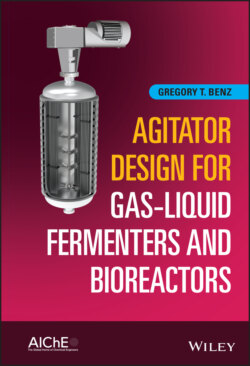Читать книгу Agitator Design for Gas-Liquid Fermenters and Bioreactors - Gregory T. Benz - Страница 15
Define Process Results
ОглавлениеThe first step in agitator design, or, for that matter, the design of any kind of process equipment, is to define the expected process result. For agitators, that could be a number of different things, such as degree of solids suspension, blend time to some specified degree of uniformity, characteristic fluid velocity, heat transfer coefficient, etc. While some or all of these process results may be needed or applicable to bioreactor design, in general, the requirement for a certain mass transfer rate is the most important and difficult to achieve. In other words, when an agitator is designed for mass transfer, the other process requirements are normally exceeded.
There are two exceptions to this. One is when the mass transfer requirement is very low (say, less than 10 mmol/l‐h). This is sometimes called micro‐aeration. In such a case, there may be minimum liquid velocities or blend time requirements. However, we feel that such cases are covered well in the general literature, such as in Refs. [1,2]. Therefore, we will not describe agitator design where velocity or blend time is the required results for low viscosity liquids. By “low viscosity,” we typically mean that the viscosity is less than 1000 cP. Viscosities less than 1000 cP typically have little effect on power draw or blending performance. However, heat transfer is affected at all viscosities, and mass transfer is affected when viscosity gets above approximately 50–80 cP.
Figure 2.1 Agitator design flow chart.
The other exception is fermentation of highly viscous liquids, such as Xanthan gum or Gellan gum. At peak concentrations in the broth, such materials may have viscosities at a shear rate of 1 per second of 30 000 cP or even higher and apparent viscosities at the impeller of 2 000–10 000 cP. They are also quite non‐Newtonian. We will describe some viscosity models and effects in Chapter 3 and specific issues with viscous fermenter design in Chapter 12.
With the foregoing in mind, the first step in our flow chart, defining process results, will focus on the required mass transfer rate, MTR. Since most fermenters consume oxygen, and the feed gas is air, most of this book will use aerobic fermentation with air feed for examples and calculations. So, we will usually refer to the mass transfer rate as the OTR, or oxygen transfer rate. Units are normally either mass per volume–time or moles per volume–time. The most common units of this type are mg/l‐h or mmol/l‐h. Relatively speaking, an “easy” fermentation would have an OTR of less than 100 mmol/l‐h, an “average” one would have around 150–200, and a difficult one would be 300 and up. There are huge implications on equipment size and power costs at these different levels.
Because mass transfer correlations are generally no more accurate than about ±30% when developed for the actual broth and can be much greater in error if generic, published correlations are used, the design OTR should be increased over the required OTR by a suitable factor.
Chapter 11 will deal with cases where the feed gas is not air. For such cases, it may not be possible to optimize power the way we present it in this flow chart, as the cost of the feed gas is not just the power required to deliver it to the tank, and there may be other process constraints.
Note that evolving gas from solution is a separate issue from dispersing gas. Evolving gas is already dispersed, though it affects power draw, performance, and mechanical behavior in a similar way to dispersing gas.
